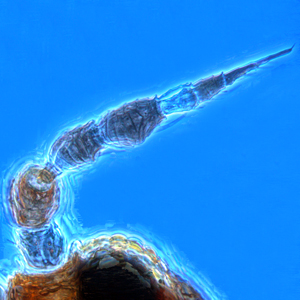Figures
Fig. 1: Antenna
Fig. 2: Head dorsal with ocellar triangle
Fig. 3: Head and Pronotum
Fig. 4: Pronotum and mesonotum
Fig. 5: Meso- and metanotum
Fig. 6: Fore- and hindwing
Fig. 7: Tergites VII and VIII
Fig. 8: Tergites IX and X
Taxonomic Information
Species:
Retithrips syriacus Mayet, 1890
Synonyms:
Retithrips bicolor Ramakrishna, 1932
Stylothrips bondari Bondar, 1924
Retithrips javanicus Karny, 1923
Dictyothrips zanoniana Del Guercio, 1918
Retithrips aegyptiacus Marchal, 1910
Thrips (Heliothrips) syriacus Mayet,
1890
Common name:
Castor thrips
Present taxonomic position:
Family: Thripidae Stephens, 1829
Subfamily: Panchaetothripinae Bagnall, 1912
Genus: Retithrips Marchal, 1910
Species Recognition
General information about the genus Retithrips:There are two species in this genus and both have unique thrips characters. The genus is described as having a wide body with heavy reticulate sculpture, antennae are thick and eight segmented with forked sense cones on segments III and IV and with the segments appearing connected and without sutures. The forewings are wide with a few vein setae on the first vein and near the costal margin of the wing there are three evenly distributed bumps.
Typical character states of Retithrips syriacus:
Body color
Mainly brown
Antennae
Number of antennal segments: 8
Segment IV - forked sensorium: extending to a point at least 30% distal to base of segment V
Segments III & IV sensoria: emergent and forked
Terminal antennal segments: very long, needle like
Head:
Head shape between compound eyes: distinctly prolonged
Sculptured reticles on head and pronotum: with internal sculptured markings
Surface of head, pronotum and fore legs: with strong reticulate sculpture, but sometimes irregular
Head posteriorly: not constricted
Prothorax
Number of pairs of elongate pronotal setae: 0-3
Number of pairs of elongate posteroangular pronotal setae: 0
Pronotum shape: rectangular
Sculptur of pronotum: without transverse striate sculpture
Mesothorax
Mesothoracic endofurca: without median spinula
Metathorax
Metanotum: with or without campaniform sensilla
Metanotum major sclerite: with two major sclerites, metascutum and metascutellum
Metanotum median area: with at least some equiangular reticulation
Metanotum sculpture: with dominant sculptured triangle medially
Metathoracic endofurca: transverse, sometimes with simple median spinula
Wings
Wings: present and more than half as long as abdomen
First vein of forewing: close to or fused to costal vein
Forewing anterior margin: with setae but no cilia or without any long setae or long cilia
Forewing color: uniformly light brown
Forewing costal setae at middle of wing: shorter than median width of wing
Forewing first vein setal row: incomplete, with setae not closely and uniformly spaced
Forewing posterior margin cilia: straight, no undulations
Forewing second vein setal row: incomplete, with setae not closely and
uniformly spaced or with no setae
Forewing surface: with two or more bubble-like
callosities
Forewings: with veins, setae and microtrichia
Legs
Mid and hind tarsi: with one segment
Abdomen:
Abdominal segment X: never tubular, longitudinally incomplete ventrally in both sexes
Abdominal tergites: without curved wing-retaining setae
Abdominal tergites IV & V median setal pair: longer than distance between their bases
Setae on abdominal tergite X: minute, scarcely visible
Tergite VIII posteromarginal comb of microtrichia: present, complete medially
Tergites III to VI sculpture on lateral thirds: comprising mainly oblique reticulations
Biology
Life history:
As with other thrips species the life cycle from egg to adult is dependent on temperature. The full cycle can take about 15 days to over a month and adults may live for more than one month producing several generations in one year depending on seasonal weather (Lewis,
1973). With greenhouse temperatures the developmental time from egg to adult can decrease to about one week.
Host plants:
Avocado, castor bean, Annona
squamosa, grapes, roses, Eucalyptus spp.
Vector capacity:
None identified
Current known distribution:
Africa, Asia, Central and South America, Europe, North America
Additional notes:
This species is generally found feeding
on the leaves of its host plants.
Bibliography
Ananthakrishnan, TN & Muraleed, N (1972): Free
amino-acids in relation to host plant preferences in polyphagous Heliothripines Rhipiphorothrips
cruentatus Hood and Retithrips syriacus (Mayet). - Current
Science 41 (23): 846-847.
Ananthakrishnan, TN, Gopichandran, R & Gurusubramanian,
G (1992): Influence of chemical profiles of host plants on the
infestation diversity of Retithrips syriacus. - Journal of Biosciences
17 (4): 483-489.
Lewis, T (1973): Thrips their biology,
ecology and economic importance. Academic Press Inc., London Ltd. 349
pp.
Medina-Gaud, S & Franqui, RA (2001): Retithrips
syriacus (Mayet), the black vine thrips (Insecta : Thysanoptera
: Thripidae) new to Puerto Rico. - Journal of Agriculture of the University
of Puerto Rico 85 (1-2): 85-89.
Moritz G, Morris DC, Mound LA (2001): ThripsID -
Pest thrips of the world. ACIAR
and CSIRO Publishing Collingwood, Victoria, Australia, CDROM ISBN
1 86320 296 X.
Moritz G, Mound LA, Morris DC, Goldarazena A (2004): Pest
thrips of the world - an identification and information system using molecular
and microscopial methods. CBIT, University of Queensland,CDROM ISBN 1-86499-781-8.
Mound, LA & Marullo, R (1996): The
thrips of Central and South America: An Introduction (Insecta: Thysanoptera).
Associated Publishers, Gainesville.
Palmer, JM, Mound, LA & Du Heaume, GJ (1989): 2. Thysanoptera,
pp. 73. In Betts, CR [ed.], CIE Guides
to Insects of Important to Man. CAB International, Wallingford.
Suresh, G & Ananthakrishnan, TN (1988): Leaf-age
correlated changes in oxidative-enzymes in Retithrips syriacus (Mayet)
infested Ricinus communis. - Current Science 57 (13): 744-746.
Wilson, TH (1975): A monograph of the subfamily Panchaetothripinae
(Thysanoptera: Thripidae). Memoirs of the American Entomological Institute
23: 1-354.
Links:
Mound, LA (2005): Thysanoptera (Thrips) of the World
- A Checklist. http://www.ento.csiro.au/thysanoptera/worldthrips.html









